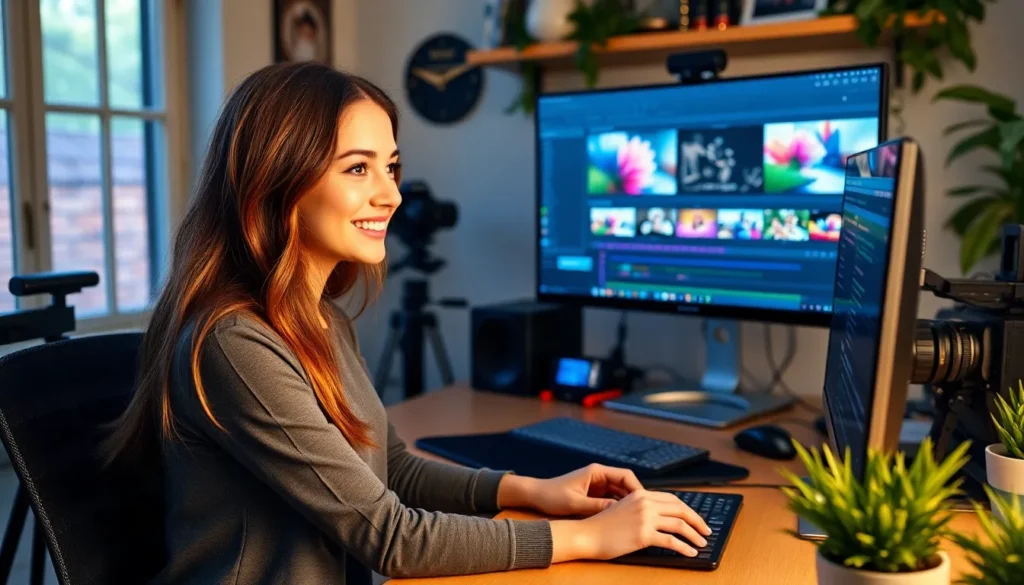In a world where everyone’s a filmmaker, mastering video editing can feel like trying to find a needle in a haystack—while blindfolded. But fear not! With a few handy tips, anyone can transform their raw footage into a cinematic masterpiece that even Spielberg would envy. Whether it’s trimming those awkward pauses or adding a splash of flair with effects, the right techniques can turn any video from drab to fab.
Table of Contents
ToggleEssential Video Editing Tips
Effective video editing transforms raw footage into compelling narratives. Mastering some basic techniques can enhance video quality and viewer engagement significantly.
Understanding Your Editing Software
Familiarity with editing software is crucial for achieving desired effects. Learning the interface helps navigate tools efficiently. Each software offers unique features, so exploring them can reveal hidden potential. Shortcuts save time and streamline the editing process. Tutorials and online resources provide valuable insights into software capabilities. Seeking community forums allows users to exchange tips and troubleshoot common issues.
Organizing Your Footage
Organized footage simplifies the editing workflow. Categorizing clips into folders based on scenes or themes promotes efficient access. Labeling files with clear, descriptive names aids in quick identification. Annotations within the software offer additional context for each clip. Backing up projects regularly protects against data loss and allows for easier recovery. Consider creating a timeline overview to visualize the story flow, making the entire editing process more coherent.
Creative Techniques for Video Editing

Effective video editing involves several creative techniques that elevate the final product. Utilizing these methods helps bring stories to life and maintain audience engagement.
Utilizing Transitions Effectively
Transitions connect different clips seamlessly. Choose transitions like fades, cuts, or wipes based on the narrative’s tone. Fades convey a soft shift, while cuts offer a more abrupt change. Additionally, applying motion transitions can enhance dynamic scenes. Consistency in transition use keeps the viewer’s focus, which makes for a smoother experience. Avoid excessive use of flashy transitions; subtlety often serves the content better.
The Power of Color Grading
Color grading enhances the emotional impact of a video. This technique adjusts the color balance and contrasts, creating a specific mood. Warmer tones can evoke a sense of comfort, while cooler shades promote calmness. Moreover, using tools for color correction ensures visual consistency throughout. Grading helps in establishing a unique style that sets apart a video from others. When executed well, color grading enriches storytelling and captivates the audience’s attention effectively.
Enhancing Audio in Your Videos
Audio plays a crucial role in video production. Elevating sound quality enhances the overall viewer experience.
Choosing the Right Music
Selecting appropriate music sets the mood for the video. Consider the theme and target audience when picking tracks. Genres like orchestral build tension, while upbeat pop tracks generate excitement. Incorporate royalty-free music to avoid copyright issues. Various websites offer collections of tracks suited for different project types. Test different options to find the sound that complements the visuals effectively.
Balancing Sound Levels
Maintaining balanced sound levels ensures clarity. Adjust voiceovers, music, and sound effects to achieve a cohesive audio experience. Utilize audio meters to monitor levels as clips play. Aim for dialogue to sit comfortably above background sounds. Soft music can enhance emotions without overpowering speech. Properly adjusting these elements contributes to a professional finish. Use tools like compressors and equalizers to refine audio quality.
Finalizing Your Edits
Finalizing edits requires attention to detail and thoughtful decision-making. This stage enhances the overall quality of the video, ensuring the final product resonates with viewers.
Exporting Options
Exporting video involves selecting the appropriate format and resolution. Common formats include MP4, MOV, and AVI, each serving different purposes. Opting for 1080p resolution is standard for high-quality content, while 4K may be ideal for cinematic projects. Settings also include bitrate adjustments, which can impact file size and quality. It’s vital to match the export settings with the intended platform—YouTube, social media, or broadcasting—to maintain optimal viewing experiences.
Quality Control Checks
Conducting quality control checks confirms the video meets professional standards. Watching the final edit multiple times helps identify any lingering issues, such as audio inconsistencies or visual glitches. It’s important to check transitions, ensuring they flow smoothly between scenes. Color grading should align with the desired mood, while audio levels need to balance effectively for clarity. Inviting feedback from peers can provide fresh perspectives, identifying elements that may require adjustments before the final release.
Mastering video editing is a journey that requires practice and creativity. By applying the tips shared in this article, editors can transform their footage into captivating stories that resonate with audiences. Emphasizing the importance of organization and technique sets a strong foundation for any editing project.
Focusing on audio and visual elements enhances the overall quality, ensuring that each video not only tells a story but also engages viewers effectively. As editors refine their skills and explore new creative techniques, they’ll find that their unique style emerges, making their work stand out in a crowded landscape.
With attention to detail and a willingness to learn, anyone can elevate their video editing game and produce content that captivates and inspires.










